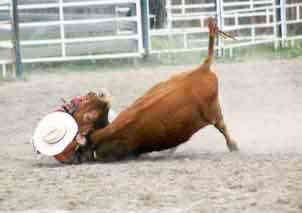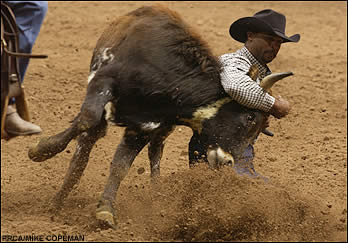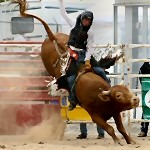 Bull riding, which is intentionally climbing on
the back of a 2,000-pound bull holding onto only a rope, emerged from
the fearless and possibly fool-hardy nature of the cowboy. The risks
are obvious. Serious injury is always a possibility for those fearless
enough to sit astride an animal that literally weighs a ton and is
usually equipped with dangerous horns. Regardless, cowboys do it, fans
love it and bull riding ranks as one of rodeo's most popular events.
Bulls are considered harder to ride than horses and the risk of injury
is far greater. Not only does the rider risk injury during the ride,
but also once he is dismounted there is the possibility of being
trampled or gored by the angry bull. The rope is wrapped around the
bull's chest, just behind the front legs. One end of the rope, called
the tail, is threaded through a loop on the other end and tightened
around the bull. The rider then wraps the tail around his hand,
sometimes weaving it through his fingers to further secure his grip. A
bell attached to the rope excites the bull, causing it to buck harder
and acts as a weight that pulls the rope off the bull once the rider
has released his grip. The bull must be ridden eight seconds. A rider
will be disqualified for being bucked off or touching the bull with his
free hand. A resined soft leather glove is worn on the hand the rider
uses to grasp the bull rope. Only the squeeze of his hand on the
handhold and the wrap of the rope's tail hold him to the bull rope. The
bull rider's chaps, perhaps more than any other event, afford
protection against scrapes, stomps and bruised. His dull roweled spurs
and vest complete his equipment list. Judges score a bull on
how hard he bucks and kicks, whether he spins, and if he rolls and
twists and changes directions during the ride. A high kicking spin is
much more difficult for the rider than is a flat spin, and a change in
direction in spin is a most difficult move for the rider to adjust to.
The rider is scored on his balance, timing, and, most important, his
degree of control. A bull rider is not required to spur the animal, as
are bronc riders, but his score is higher if he does. Watch the motion
of his free arm, for there is the key to balance in the ballet he
performs on the bull's back. Bull riding, which is intentionally climbing on
the back of a 2,000-pound bull holding onto only a rope, emerged from
the fearless and possibly fool-hardy nature of the cowboy. The risks
are obvious. Serious injury is always a possibility for those fearless
enough to sit astride an animal that literally weighs a ton and is
usually equipped with dangerous horns. Regardless, cowboys do it, fans
love it and bull riding ranks as one of rodeo's most popular events.
Bulls are considered harder to ride than horses and the risk of injury
is far greater. Not only does the rider risk injury during the ride,
but also once he is dismounted there is the possibility of being
trampled or gored by the angry bull. The rope is wrapped around the
bull's chest, just behind the front legs. One end of the rope, called
the tail, is threaded through a loop on the other end and tightened
around the bull. The rider then wraps the tail around his hand,
sometimes weaving it through his fingers to further secure his grip. A
bell attached to the rope excites the bull, causing it to buck harder
and acts as a weight that pulls the rope off the bull once the rider
has released his grip. The bull must be ridden eight seconds. A rider
will be disqualified for being bucked off or touching the bull with his
free hand. A resined soft leather glove is worn on the hand the rider
uses to grasp the bull rope. Only the squeeze of his hand on the
handhold and the wrap of the rope's tail hold him to the bull rope. The
bull rider's chaps, perhaps more than any other event, afford
protection against scrapes, stomps and bruised. His dull roweled spurs
and vest complete his equipment list. Judges score a bull on
how hard he bucks and kicks, whether he spins, and if he rolls and
twists and changes directions during the ride. A high kicking spin is
much more difficult for the rider than is a flat spin, and a change in
direction in spin is a most difficult move for the rider to adjust to.
The rider is scored on his balance, timing, and, most important, his
degree of control. A bull rider is not required to spur the animal, as
are bronc riders, but his score is higher if he does. Watch the motion
of his free arm, for there is the key to balance in the ballet he
performs on the bull's back. |
 Bull riding, which is intentionally climbing on
the back of a 2,000-pound bull holding onto only a rope, emerged from
the fearless and possibly fool-hardy nature of the cowboy. The risks
are obvious. Serious injury is always a possibility for those fearless
enough to sit astride an animal that literally weighs a ton and is
usually equipped with dangerous horns. Regardless, cowboys do it, fans
love it and bull riding ranks as one of rodeo's most popular events.
Bulls are considered harder to ride than horses and the risk of injury
is far greater. Not only does the rider risk injury during the ride,
but also once he is dismounted there is the possibility of being
trampled or gored by the angry bull. The rope is wrapped around the
bull's chest, just behind the front legs. One end of the rope, called
the tail, is threaded through a loop on the other end and tightened
around the bull. The rider then wraps the tail around his hand,
sometimes weaving it through his fingers to further secure his grip. A
bell attached to the rope excites the bull, causing it to buck harder
and acts as a weight that pulls the rope off the bull once the rider
has released his grip. The bull must be ridden eight seconds. A rider
will be disqualified for being bucked off or touching the bull with his
free hand. A resined soft leather glove is worn on the hand the rider
uses to grasp the bull rope. Only the squeeze of his hand on the
handhold and the wrap of the rope's tail hold him to the bull rope. The
bull rider's chaps, perhaps more than any other event, afford
protection against scrapes, stomps and bruised. His dull roweled spurs
and vest complete his equipment list. Judges score a bull on
how hard he bucks and kicks, whether he spins, and if he rolls and
twists and changes directions during the ride. A high kicking spin is
much more difficult for the rider than is a flat spin, and a change in
direction in spin is a most difficult move for the rider to adjust to.
The rider is scored on his balance, timing, and, most important, his
degree of control. A bull rider is not required to spur the animal, as
are bronc riders, but his score is higher if he does. Watch the motion
of his free arm, for there is the key to balance in the ballet he
performs on the bull's back.
Bull riding, which is intentionally climbing on
the back of a 2,000-pound bull holding onto only a rope, emerged from
the fearless and possibly fool-hardy nature of the cowboy. The risks
are obvious. Serious injury is always a possibility for those fearless
enough to sit astride an animal that literally weighs a ton and is
usually equipped with dangerous horns. Regardless, cowboys do it, fans
love it and bull riding ranks as one of rodeo's most popular events.
Bulls are considered harder to ride than horses and the risk of injury
is far greater. Not only does the rider risk injury during the ride,
but also once he is dismounted there is the possibility of being
trampled or gored by the angry bull. The rope is wrapped around the
bull's chest, just behind the front legs. One end of the rope, called
the tail, is threaded through a loop on the other end and tightened
around the bull. The rider then wraps the tail around his hand,
sometimes weaving it through his fingers to further secure his grip. A
bell attached to the rope excites the bull, causing it to buck harder
and acts as a weight that pulls the rope off the bull once the rider
has released his grip. The bull must be ridden eight seconds. A rider
will be disqualified for being bucked off or touching the bull with his
free hand. A resined soft leather glove is worn on the hand the rider
uses to grasp the bull rope. Only the squeeze of his hand on the
handhold and the wrap of the rope's tail hold him to the bull rope. The
bull rider's chaps, perhaps more than any other event, afford
protection against scrapes, stomps and bruised. His dull roweled spurs
and vest complete his equipment list. Judges score a bull on
how hard he bucks and kicks, whether he spins, and if he rolls and
twists and changes directions during the ride. A high kicking spin is
much more difficult for the rider than is a flat spin, and a change in
direction in spin is a most difficult move for the rider to adjust to.
The rider is scored on his balance, timing, and, most important, his
degree of control. A bull rider is not required to spur the animal, as
are bronc riders, but his score is higher if he does. Watch the motion
of his free arm, for there is the key to balance in the ballet he
performs on the bull's back. 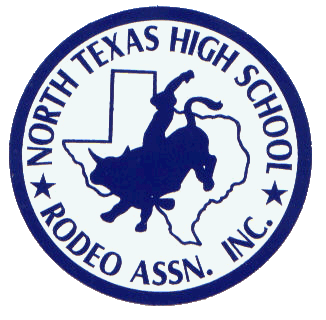
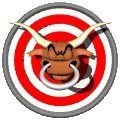
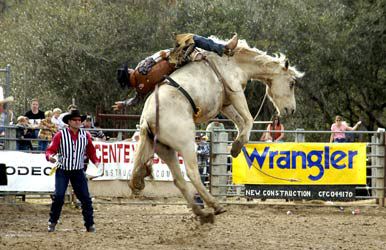 Bareback
bronc riding is a rough and explosive rodeo event. The most physically
demanding of all the rodeo events, and the first event to compete at
most rodeos. Cowboys ride rough horses without the benefit of saddle or
rein.They ride 'bareback' on the horse and use a leather rigging, which
looks like a heavy piece of
leather with a suitcase handle. The cowboys ride one handed and cannot
touch themselves or the horse with their free hand. As with saddle
bronc riding the "mark out" rule (the cowboys must have their spurs
touching the animal above the point of the horse's shoulder on its
first jump out of the bucking chutes) is in effect. The cowboys spur
the horse from shoulder to rigging, in a frantic style trying make a
qualified ride of 8 seconds. Once the ride is completed, pick-up men
swoop in to 'pick up' the rider and set him safely on the ground.
Cowboys are judged on their control and spurring technique, and the
horses are judged on their power, speed, and agility. Cowboys competing
in bareback take a lot of punishment on their arm, neck, and back due
to the power and quickness of the bareback horses.
Bareback
bronc riding is a rough and explosive rodeo event. The most physically
demanding of all the rodeo events, and the first event to compete at
most rodeos. Cowboys ride rough horses without the benefit of saddle or
rein.They ride 'bareback' on the horse and use a leather rigging, which
looks like a heavy piece of
leather with a suitcase handle. The cowboys ride one handed and cannot
touch themselves or the horse with their free hand. As with saddle
bronc riding the "mark out" rule (the cowboys must have their spurs
touching the animal above the point of the horse's shoulder on its
first jump out of the bucking chutes) is in effect. The cowboys spur
the horse from shoulder to rigging, in a frantic style trying make a
qualified ride of 8 seconds. Once the ride is completed, pick-up men
swoop in to 'pick up' the rider and set him safely on the ground.
Cowboys are judged on their control and spurring technique, and the
horses are judged on their power, speed, and agility. Cowboys competing
in bareback take a lot of punishment on their arm, neck, and back due
to the power and quickness of the bareback horses. 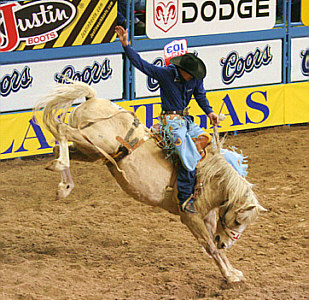
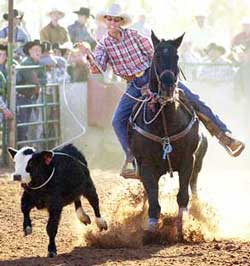 Like bronc riding,
calf roping is an event that was born on the ranches of the Old West.
Sick calves were roped and tied down for medical treatment. Success in
calf roping depends largely on the teamwork between a cowboy and his
horse. The luck of the draw is also a factor. A calf that runs fast or
kicks hard can foil a roper's finest effort.
Like bronc riding,
calf roping is an event that was born on the ranches of the Old West.
Sick calves were roped and tied down for medical treatment. Success in
calf roping depends largely on the teamwork between a cowboy and his
horse. The luck of the draw is also a factor. A calf that runs fast or
kicks hard can foil a roper's finest effort.